Language Learning Games: Quest Games in SpatialChat
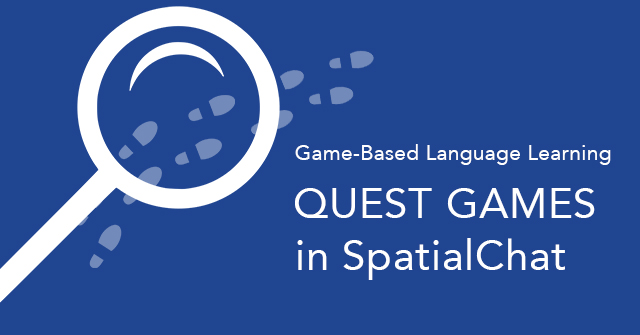
by Edwige Simon, PhD, Instructional Technology and Online Learning Director
Spatial Chat is a videoconferencing environment that allows users to move freely on a virtual background and hold small group conversations using audio proximity. As you can see on the screenshot below, the user (located inside the circle) can move around freely against the background, as well as zoom in (to read the menu) and out to explore the space. As users get closer, they can hear each other. As they move away from the zone of audio proximity (see faint circle in screenshot below), the sound starts fading and ultimately turns off.
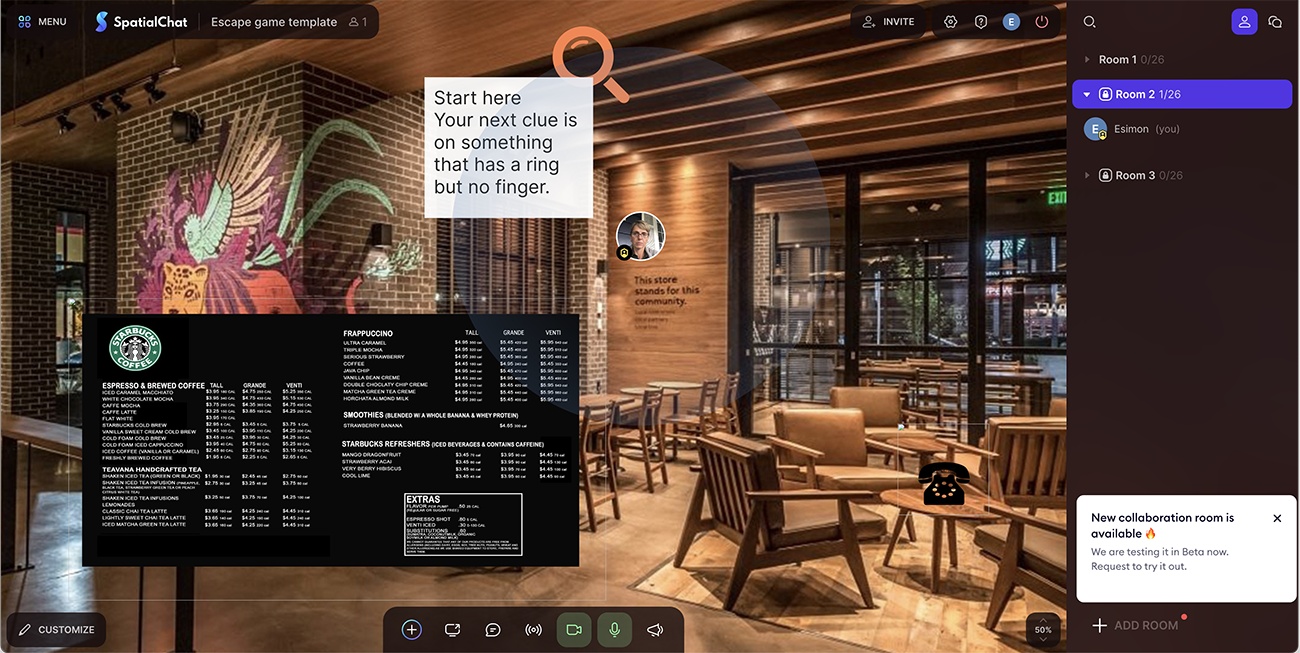
Various features of Spatial Chat allow you to choose from the selection of backgrounds available in the library or upload your own. In addition, you can pin photos, videos, gifs, links, and text to the background or share a Miro whiteboard.
SpatialChat is quite different from other video conference tools such as Zoom because users can move freely around the space. Teachers can form small groups and quickly move between groups to provide feedback or answer questions. In this respect, it offers more seamless opportunities for online group conversations than the rather clunky Zoom break-out rooms.
Spatial Chat is free for up to 5 users and one space. However, solo educators may apply for a license that will allow them to bring up to 25 users into their spaces for free. Here is the link to apply for the 25 tier.
Puzzle Games
Puzzle games are a popular form of video games where users must explore a series of spaces to find clues that will lead them to the next puzzle. They are also often called mystery games or hidden object games (HOGs). Commercial HOGs present opportunities for language learning as long as the teacher is willing to spend the time designing wrap-around activities. For more information on how to integrate digital games in the classroom, visit the Games2Teach website, where you will find a review of the HOG game Dark tales, Edgar Allan Poe’s Murders in the Rue Morgue, which can be played in French, Germany, English, and Spanish. You can download the review packet from the games2teach site. Although the Games2Teach project is no longer funded, resources remain available to the public.
Mystery Games in Spatial Chat
SpatialChat presents opportunities for creating quest games. The virtual background offers an immersive environment and being able to add links, images, and text to the background opens the door to creative uses of puzzles for students to solve. Teachers can upload authentic backgrounds such as a French bakery, a German supermarket, or a neighborhood in Mexico.
Game Example
To pilot this idea, I created a simple game in English that students can play in pairs. It follows the typical format of solving a series of clues to get to the resolution.
Students are presented with this initial scenario:
You are in charge of ensuring the safety of a vital informant. However, while you were chatting with your partner over coffee, the informant left and locked you in the office. Your mission is to get out of the office and locate the informant.
The game is composed of 6 challenges spread out over three rooms. Students play the game in pairs. You may try to play the game yourself (click here to enter the first room), or you may read on for a game walkthrough.
Room 1: The Office
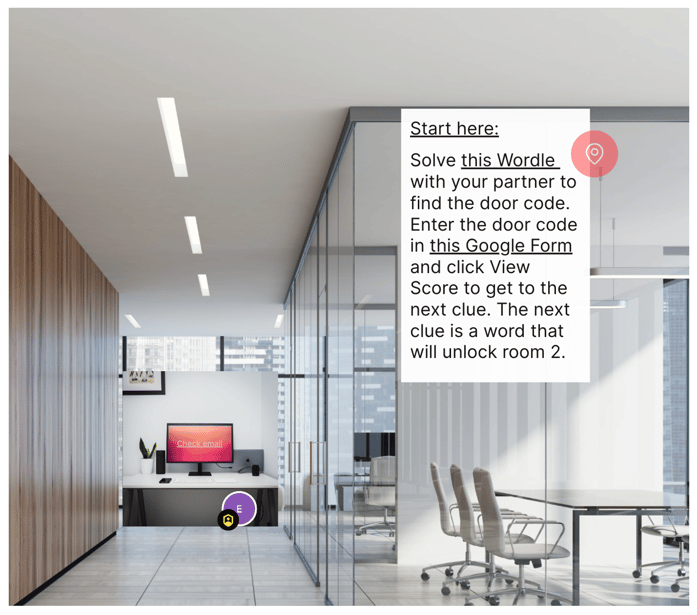
Students spawn (see red marker) next to the first set of instructions.
Challenge #1 (room one, the office)
Students need to solve a wordle (the solution is ESCAPE) and enter the word in a google form which will get them information on how to find the next clue (check the informant’s email on the computer screen).
Challenge #2 (room one, the office)
Students read 3-4 different emails, one of which contains a clue revealing where the informant is headed (location = door code: Starbucks).
Challenge #3 (Room 2, Starbucks coffeeshop)
Students get to Starbucks and read this text: your next clue is on something that has a ring but no finger (a phone).
Challenge #4 (Room 2, Starbucks coffeeshop)
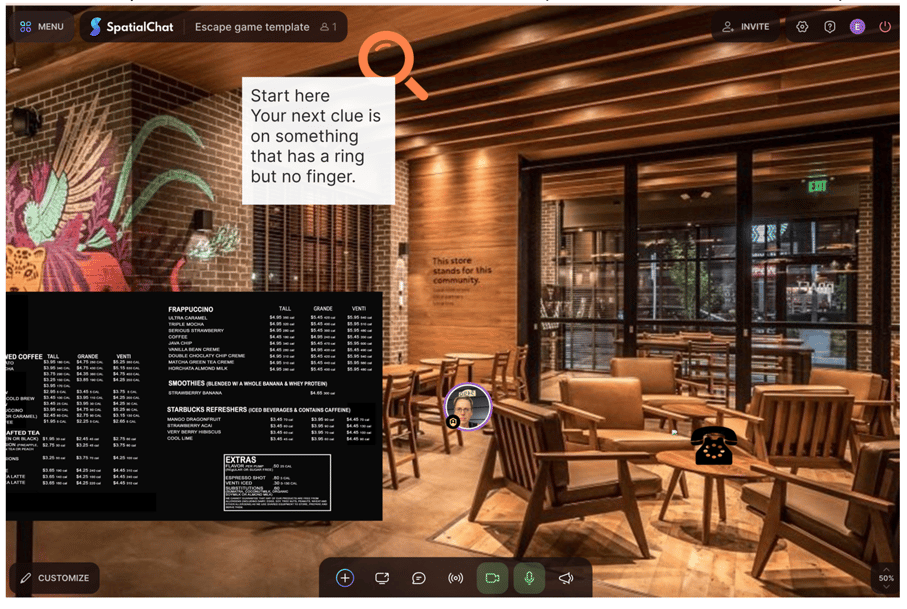
If they click on the phone, they will hear the following text (recorded using Vocaroo).
I like caffeine but not coffee, I hate cold drinks, I like my spices, especially cardamon and cinnamon but sugar in small amounts. Keep my order under $4.
They will need to use the information from the recording and read the menu to choose a drink that meets all the specifications. The name of the drink unlocks room 3 (the answer is tall classic chai latte)
Challenge #5 (Room 4, map of NYC)
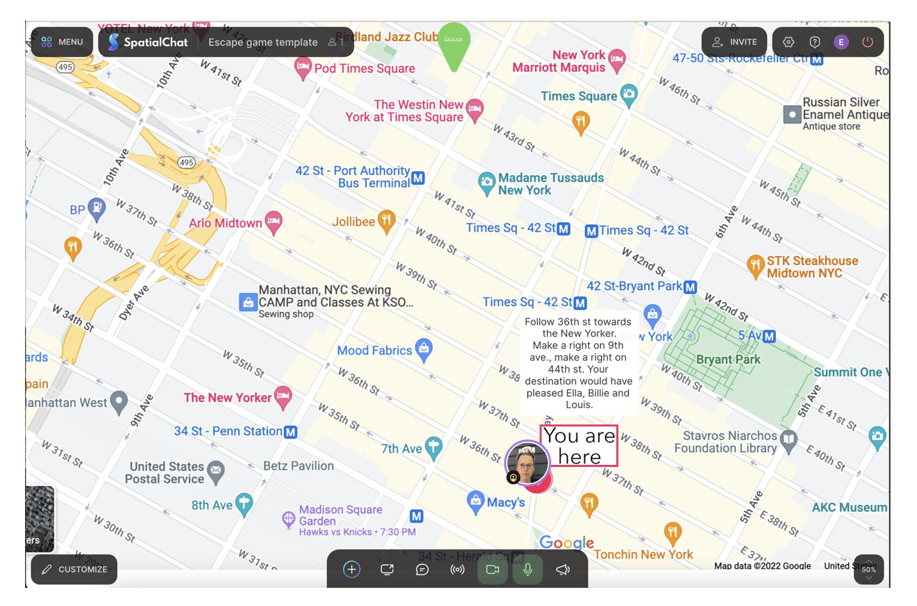
Students spawn at the corner of 36th and 6th ave in New York City. When they follow the directions to the clue, they reach the Birdland jazz club.
Challenge #6 (Room 4, map of NYC)
Students click on the green pin and get to a GoogleDoc listing reasons why the informant refuses to testify. They have to come up with a counterargument for each reason.
Challenges of Escape Games in the Language Classroom
Not all students enjoy playing games in the classroom. Students who know how to go to school may get nervous when they encounter a situation where they don’t know how to be successful. There should be no stakes, no grades attached to this activity. However, there should be a winner (the team that completes the game first).
Good games are hard to design. You need to develop a compelling and coherent scenario and challenges that are just difficult enough to keep the students engaged. In the game I designed, some challenges are on the more difficult side. Some of the links are a bit hidden in the background. If the game is too easy, students will solve it in a few minutes. If it’s too hard, they’ll give up.
As students get excited, they also get competitive and want to revert to using the L1. Playing the game in class will allow you to deduct points when you hear English. In addition, ensure scaffolding is provided so students can stay in the target language.
Mystery games are meant to be played alone and are not inherently collaborative. You will need to use your ingenuity to create tasks that require a collaborative approach to get solved. If the task is challenging, students will need to discuss potential solutions. Again, playing the game in class will help ensure students stay in the target language.
I hope you’ll decide to give this a try. Let us know in the comment section how it went! Learn more about using teacher tools online (including ChatGPT for language teachers) at our Teacher PD tech workshops.

.png?width=352&name=Plateau%20(1).png)
